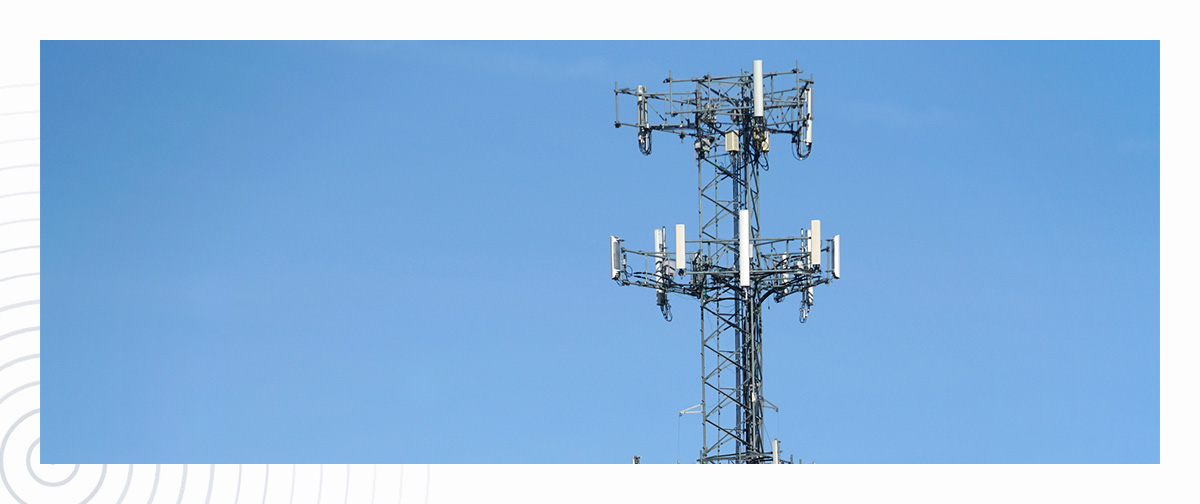How Do Telecommunication Towers Work?

Telecommunication towers, also known as cell towers, receive and transmit radio waves to facilitate wireless communication between mobile devices. These towers enable users to make phone calls, send text messages and access the internet, even as they move from one place to another. Towers create a network of cells, or coverage areas, to ensure people stay connected wherever they may be.
Cell towers have the same components, but they come in several different forms to suit the area’s coverage needs. Learn more about how these towers work, what it takes to build one, and how Aluma Towers can assist you with your telecom tower requirements.
Types of Cell Towers
Telecommunication towers come in several forms to meet various location and coverage needs.
1. Guyed Towers
Guyed towers are supported by guy wires anchored to the ground in all directions. They are the most common type of cell tower because they have a slender, lightweight design while still providing stability. They are a cost-effective option for medium heights, though they require a substantial amount of land for the guy wire anchors.
2. Unguyed Towers
As the name suggests, unguyed towers do not need any guy wires. These freestanding towers require robust construction to withstand wind and weather. They are suitable for areas with limited space for guy wire anchoring.
Unguyed towers include monopoles and lattice towers. Monopoles are single, freestanding poles often found in urban and suburban areas that usually reach 50 to 200 feet. Lattice towers are triangular- or square-shaped self-supporting towers that can reach greater heights than monopoles, usually 200 to 400 feet.
3. Open Trailer Towers
For temporary or emergencies, an open trailer tower is ideal. The tower is mounted onto a trailer, making it quickly deployable for harsh or remote locations. They often come with hydraulic or pneumatic masts for easy setup and teardown.
4. Cell-on-Wheels (COW)
A COW is a portable cellular site on a wheeled platform. It is easy to tow on short notice for temporary needs, such as network expansion, disaster recovery or events. They are often equipped with generators and backup power systems to provide rapid and convenient solutions for needs in remote areas or across rough terrain.
5. Stealth Towers
Stealth towers are disguised to blend in with their surroundings due to local zoning regulations or aesthetic concerns. They may be designed to look like trees, flag poles, clock towers, church steeples, cacti or existing structures or signs. Constructing these towers often requires additional materials to help them hide in plain sight, and they are usually smaller and less efficient.
Cell Tower Components
While there are many types of cell towers, they all use the same components to facilitate wireless communication. Key components include:
- Antenna systems: Antennas help receive and transmit radio waves from within the tower’s coverage area. There are many antenna types. The two most common are panel antennas, which are flat, rectangular and versatile, and dish antennas, which are large, circular and used for point-to-point communication.
- Transceivers: After antennas receive radio waves, a transceiver converts the waves into electrical signals. It also converts electrical signals into radio waves to be transmitted by antennas.
- Coaxial cables: These specialized cables connect antennas to transceivers, enabling them to communicate. They possess low signal-loss properties, allowing for efficient data transmission with minimal interference.
- Tower structure: The tower, or mast, is usually constructed of steel or concrete for stability. The taller a tower and its antennas, the better their line of sight and the broader the area they can cover.
- Equipment shelters: Cell towers have specially designed enclosed shelters to house base station equipment, such as transceivers, climate control systems and security features. They keep equipment running smoothly by protecting it from the elements and other outside forces.
How Communication Towers Transmit and Receive Signals
Cell towers rely on key components to handle radio waves and ensure they reach their intended destination.
1. Radio Wave Propagation
Cell towers use antennas to send and capture radio waves. They use the radiofrequency (RF) portion of the electromagnetic spectrum to transmit and receive signals. Many factors can affect radio wave propagation, including wave frequency, the signal’s power and any obstacles that may be in the signal’s path.
2. Cellular Network Architecture
A telecommunication tower provides coverage for a specific geographic area known as a cell. Cells vary in size and shape based on population density, terrain and service demand. Towers transmit and receive radio signals within their designated area, but when users move from one coverage area to another, they will experience a seamless handoff between adjacent towers.
3. Backhaul Connections
A backhaul connection links cell towers to the core network infrastructure. Cell towers can use physical fiber optic cables or wireless links, like microwave dishes, to provide backhaul connections. When to use fiber optic cables or wireless links depends on the cell’s location, terrain and accessibility.
Tower Site Selection and Construction
Proper site selection and tower construction are crucial to ensuring adequate coverage for the area.
1. Coverage Requirements Planning
Determining coverage requirements is one of the first steps to selecting the right cell tower to construct and where to put it. Determine the area’s coverage needs based on the local population and demand for wireless communication. You will also need to assess the terrain and any potential obstacles that could affect signal strength, such as building structures or geographical features.
RF propagation modeling software can help simulate signal propagation in the area. It can identify potential coverage gaps and help you choose an appropriate tower height.
2. Site Acquisition
If you plan to build a permanent cell tower, you must research potential sites and look into leasing the land or a rooftop space. You must also consider local zoning and permitting needs. Some areas may require a stealth tower to preserve the local environment and aesthetics.
As you prepare a site for tower construction, you may need to perform an environmental assessment. The Federal Communications Commission (FCC) often requires these reviews to evaluate potential environmental impacts on the area. Towers over 200 feet or built near airports need approval from the Federal Aviation Administration (FAA).
3. Tower Construction Process
After you acquire a site and complete all necessary assessments and permitting, you can begin construction. A strong foundation is crucial for withstanding wind and weather conditions. Most towers can be assembled on-site with prefabricated components and specialized lifting equipment.
Construction requirements and timelines will vary depending on the type of cell tower you build. Portable options will be simpler to construct and get on-site when needed.
4. Ongoing Maintenance and Monitoring
Regular communication tower maintenance and monitoring ensure reliable coverage, prevent downtime and minimize damage. Conduct frequent inspections to assess structural integrity and equipment performance. Preventive maintenance and cleaning can promote longevity and optimal functionality.
Many tools enable remote equipment performance monitoring. You can collect data from sensors on the cell tower to check on generators, fuel tanks, cooling systems, security concerns and environmental conditions. Detecting issues early can enhance performance, reduce costs and optimize resource use.
Aluma Tower Solutions for Telecommunications
Aluma Tower offers reliable, long-lasting telecommunication towers to meet your industry’s specific needs. Our equipment selection includes portable options that enable you to connect from remote locations while avoiding heavy licensing or permitting. Some of our solutions include:
- Telescopic unguyed towers: Our T2 Series is a lightweight, self-supporting, rapidly deployable tower option. It can be freestanding or coupled to a trailer for mobile telescopic solutions.
- Open trailer towers: When you need a rugged cell tower for challenging off-road conditions, choose one of our open trailer towers. The trailers can be outfitted with different tower systems to suit your requirements.
- Trailer tower with shelters: Our COW units enable you to establish communications in a short time frame. The simple yet functional design makes it easy to transport and deploy in various locations.
Learn More About Mobile Telecom Tower Solutions
Aluma Tower is a leading mobile tower company dedicated to meeting your needs. Contact us today to learn more about our mobile telecommunication tower options.
